Nestled in the serene hills of Uttarakhand, Champawat Fort stands as a testament to the rich history and architectural prowess of the Kumaon region. This ancient fort, once the seat of the Chand dynasty rulers, offers a glimpse into the regal past and cultural heritage of Champawat.
Historical Significance
Champawat Fort, built during the medieval period, was the capital of the Chand rulers before they moved to Almora. The fort’s strategic location provided a vantage point to oversee the surrounding valleys and protect the kingdom from invasions. It is said that the fort was constructed by King Som Chand, the founder of the Chand dynasty, in the 10th century.
Architectural Marvel
The fort’s architecture reflects a blend of traditional Kumaoni and Rajput styles, characterized by intricately carved wooden doors, stone walls, and expansive courtyards. The fort’s design showcases the architectural ingenuity of the Chand rulers, with features such as narrow passages, hidden tunnels, and elevated watchtowers that served both defensive and residential purposes.
Cultural and Religious Importance
Champawat Fort is not just a historical monument; it also holds cultural and religious significance. Within the fort complex lies the ancient Baleshwar Temple, dedicated to Lord Shiva. This temple, known for its exquisite stone carvings and sculptures, attracts devotees and history enthusiasts alike. The Nagnath Temple, dedicated to Lord Vishnu, is another notable religious site within the vicinity of the fort.
Attractions and Activities
Visitors to Champawat Fort can explore its historical remnants, including the ancient gates, royal palaces, and defense structures. The panoramic views from the fort offer a mesmerizing sight of the lush green valleys and distant Himalayan peaks. The fort’s surroundings are also ideal for nature walks and photography, providing a peaceful escape into the lap of nature.
Nearby Attractions to Champawat Fort
Baleshwar Temple
This 12th-century temple dedicated to Lord Shiva is known for its intricate stone carvings and beautiful architecture. Baleshwar Temple is a significant religious site and a fine example of medieval temple art.
Kranteshwar Mahadev Temple
Kranteshwar Mahadev temple is located on a hilltop, this temple is dedicated to Lord Shiva and offers panoramic views of the surrounding area. It’s also known as Kandev and is a peaceful spot for meditation and reflection.
Ek Hathiya Ka Naula
Ek Hathiya Ka Naula an ancient water reservoir is believed to have been built by a one-handed artisan. The unique architectural style and historical significance make it an interesting visit.
Lohaghat
Lohaghat is a picturesque hill town known for its scenic beauty and pleasant climate. Lohaghat is an excellent spot for nature walks, bird watching, and exploring local culture.
Abbott Mount
Abbott Mount is a charming hill station offering panoramic views of the Himalayan ranges. It is an ideal place for trekking, bird watching, and enjoying the tranquil environment. The church and colonial-era cottages add to its old-world charm.
Mayawati Ashram
Mayawati Ashram also known as Advaita Ashrama, was established by Swami Vivekananda. The ashram is a serene place for meditation, yoga, and studying Vedantic philosophy.
Nagnath Temple
Nagnath temple is dedicated to Lord Shiva, known for its intricate wood carvings and historical significance. It’s an important religious site for locals.
Tips for Visiting
- Travel Preparation: Carry comfortable footwear, water, snacks, a camera, and warm clothing if visiting during winter.
- Local Guides: Consider hiring a local guide for detailed insights into the history and significance of these sites.
- Accommodations: Book accommodations in advance, especially during peak tourist seasons.
Preservation and Tourism
Efforts are being made to preserve Champawat Fort and its associated structures to maintain its historical integrity and promote tourism. The fort, with its rich history and cultural heritage, has the potential to attract tourists from around the world, contributing to the local economy and raising awareness about the region’s historical significance.
Conclusion
Champawat Fort stands as a proud sentinel of Uttarakhand’s illustrious past. Its historical, architectural, and cultural importance make it a must-visit destination for history buffs, architecture enthusiasts, and travelers seeking a connection with India’s rich heritage. A visit to this fort is not just a journey through time but also an opportunity to appreciate the grandeur and legacy of the Chand dynasty.
FAQs about Champawat Fort
1. What is Champawat Fort?
Champawat Fort is a historical fort located in the town of Champawat in Uttarakhand, India. It was once the seat of power for the Chand dynasty, which ruled the Kumaon region.
2. Where is Champawat Fort located?
The fort is situated in the Champawat district of Uttarakhand, India. Champawat town is approximately 76 kilometers from Pithoragarh and around 160 kilometers from the nearest railway station, Kathgodam.
3. What is the historical significance of Champawat Fort?
Champawat Fort served as the capital of the Chand dynasty, which ruled Kumaon from the 10th to the 18th century. It is a symbol of the region’s rich history and cultural heritage.
4. What are the visiting hours for Champawat Fort?
The fort is typically open to visitors from sunrise to sunset. However, it’s advisable to check with local authorities or guides for specific visiting hours and any seasonal variations.
5. Is there an entry fee to visit Champawat Fort?
There is usually no entry fee to visit the fort. However, donations for the maintenance and preservation of the site are appreciated.





